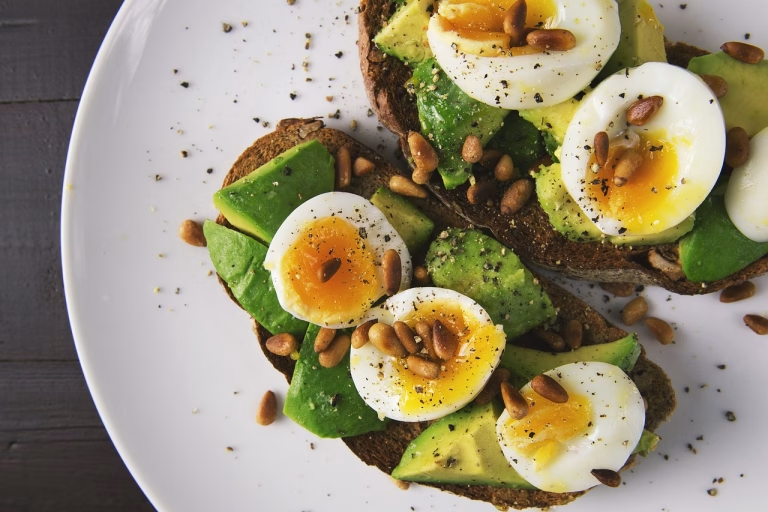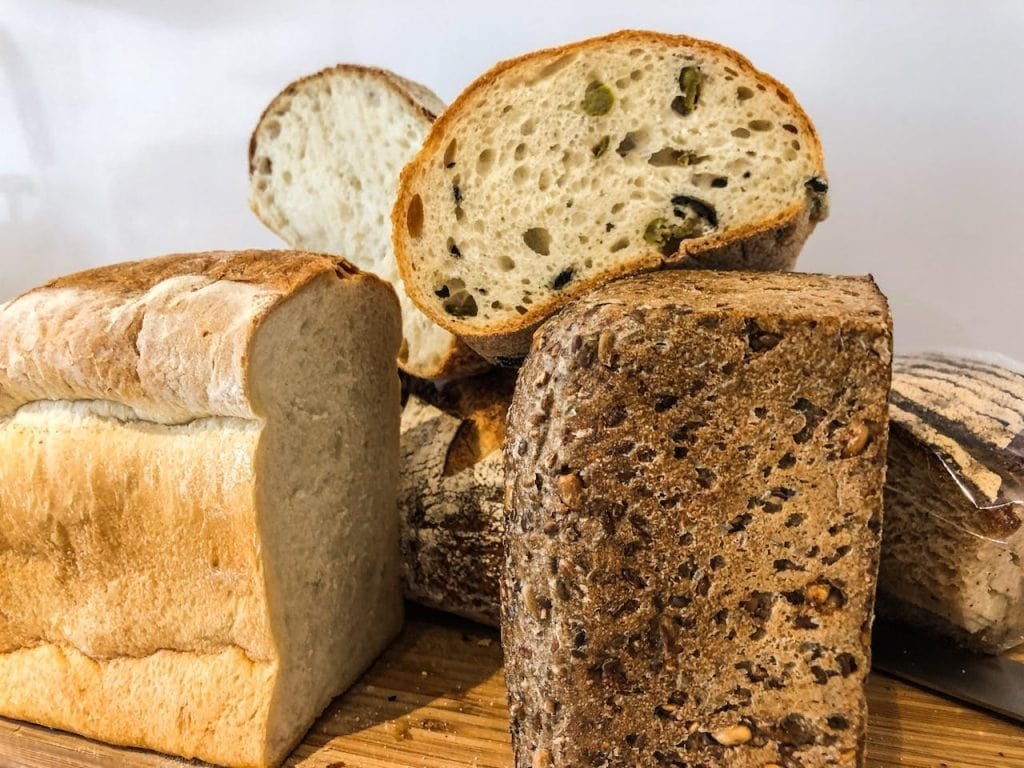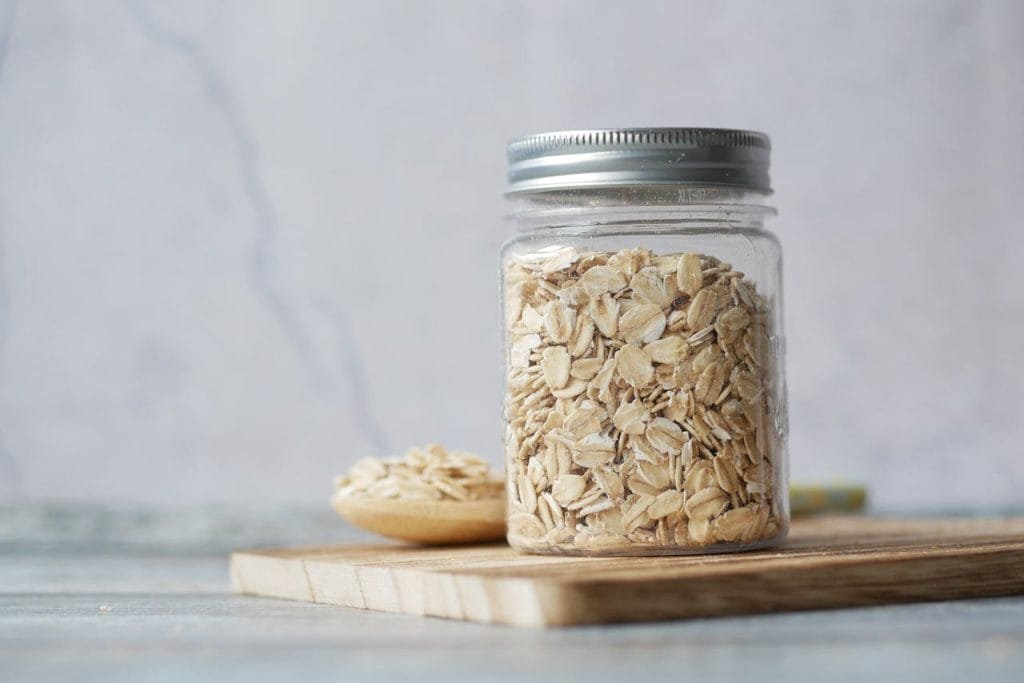You can buy so many varieties and brands of bread these days, from very cheap supermarket white bread to artisan sourdough bread that costs a small fortune. Hence, comparing bread brands is not easy, and there will be a lot of variation from brand to brand, but an average estimation can help us decide what bread is the healthiest, most nutritious, and best suited for our individual needs.
I have chosen the 11 most popular breads in the UK to compare their nutritional value and the Glycemic Index.
The table includes: White Bread, Wholemeal Bread, Sourdough, Brown Bread, Granary Bread (whole grain wheat flour mixed with malted wheat grains), Rye Bread, Bloomer bread, Baps, Crumpets, Baguettes, and Ciabatta. I know crumpets would not be classed as bread traditionally, but we all love them so much that I thought I would include them.
To compare the nutritional values of different types of bread, I’ll focus on key nutritional metrics per typical serving size, which is often around one slice (30 grams). These values can vary significantly based on the brand and recipe. The values provided here are approximations to give you a general idea of the nutritional differences between different kinds of bread.
A table of different bread type nutrition per serving:
| Bread Type | Calories (kcal) | Carbohydrates (g) | Dietary Fiber (g) | Protein (g) | Fat (g) | Sugar (g) | Sodium (mg) | Glycemic Index (GI) |
|---|---|---|---|---|---|---|---|---|
| White Bread | 80 | 15 | 1 | 3 | 1 | 1.5 | 120 | 75 |
| Wholemeal Bread | 90 | 17 | 3 | 4 | 1 | 1.2 | 115 | 69 |
| Sourdough | 85 | 17 | 2 | 3 | 0.5 | 1 | 130 | 54 |
| Brown Bread | 85 | 16 | 2 | 3 | 1 | 1.3 | 120 | 72 |
| Granary Bread | 90 | 18 | 3 | 4 | 1 | 1.5 | 125 | 65 |
| Rye Bread | 80 | 15 | 2 | 3 | 1 | 1 | 110 | 56 |
| Bloomer | 90 | 18 | 2 | 4 | 1 | 1.4 | 125 | 70 |
| Baps | 100 | 20 | 1 | 4 | 2 | 2 | 150 | 73 |
| Crumpets | 89 | 18 | 1 | 3 | 0.4 | 1 | 120 | 55 |
| Baguettes | 85 | 17 | 1 | 3 | 1 | 1.2 | 130 | 95 |
| Ciabatta | 95 | 20 | 1 | 4 | 1 | 1.5 | 140 | 58 |
Bread Nutrition findings
The table reveals a range of calories per slice from 80 to 100 kcal, with Baps having the highest calorie count. Wholemeal, Granary Bread, and Bloomer have higher levels of fibre (3g). Protein content is pretty consistent across most bread types, around 3-4g, while fat content varies slightly, with Baps having the highest at 2g. Sugar content is generally low, with a range of 1.0 to 2.0g, and sodium content varies from 110mg in Rye Bread to 150mg in Baps.
Bread Glycemic Index
I want to highlight the glycemic Index as it helps you decide which bread is the healthiest in spiking sugar blood levels.
| Bread Type | Glycemic Index (GI) | GI Classification |
|---|---|---|
| White Bread | 75 | High |
| Wholemeal Bread | 69 | Medium |
| Sourdough | 54 | Low |
| Brown Bread | 72 | High |
| Granary Bread | 65 | Medium |
| Rye Bread | 56 | Medium |
| Bloomer | 70 | High |
| Baps | 73 | High |
| Crumpets | 55 | Low |
| Baguettes | 95 | High |
| Ciabatta | 58 | Medium |
This table shows that sourdough, crumpets and rye bread have lower GI values, making them better choices for people monitoring blood sugar levels. The body absorbs These breads more slowly, leading to a gradual rise in blood sugar levels rather than sharp spikes.
On the other hand, Baguettes have the highest GI, which indicates that they may cause a quicker rise in blood sugar.
What is the Glycemic Index (GI)?
The Glycemic Index (GI) measures how quickly food raises blood sugar levels. The scale runs from 0 to 100, with higher values given to foods that cause the fastest rise (pure glucose serves as a reference point at 100).
Food is classified as:
- low (GI ≤ 55),
- medium (GI 56-69)
- high (GI ≥ 70) GI
Which Bread Is The Healthiest?
Is bloomer bread healthy? Is granary bread healthy? Here is the verdict.
The Glycemic Index and dietary fibre are significant indicators of the healthiness of bread. Lower GI values are preferable for blood sugar management, while higher dietary fibre is better for digestion and satiety. These metrics, along with a balanced profile of macronutrients, determine the overall nutritional value of the bread.
Top 3 Healthiest Breads:
-
Sourdough Bread:
Is a more nutritious option due to its natural fermentation process, making it easier to digest, improving nutrient absorption, and lowering the glycemic index, resulting in a slower rise in blood sugar levels. The fermentation also reduces gluten and phytic acid, enhancing mineral availability. While baking kills most probiotics, the prebiotics remain, supporting gut health. Sourdough bread has a rich flavor, longer shelf life without preservatives, and can be more tolerable for those with mild gluten sensitivities.
-
Rye Bread:
Its low GI of 56, moderate calories, and balanced nutritional profile support a steady energy release.
-
Wholemeal Bread:
This is another healthy option. It is higher in dietary fiber at 3g, has a relatively low GI of 69, and is balanced in nutrients.
3 Worst Breads:
-
Baguettes
have the highest GI of 95, indicating that despite having moderate nutrients, they can cause a rapid spike in blood sugar levels.
-
Baps:
Higher in calories and fat, with the lowest fibre content at 1g and a high GI of 73.
-
Bloomer Bread:
Is Bloomer Bread Healthy? Although it is not the worst in any category, its combination of moderate-to-high GI (70), lower dietary fiber (2g), and higher sodium levels makes it not the best option.
FAQ:
Is Malted Bloomer Bread More Healthy Than Bloomer Bread?
Bloomer bread (especially wholemeal ) is generally the healthier choice if you’re focused on managing blood sugar levels or maximizing fiber. However, malted bloomer bread can still be part of a healthy diet if it contains whole ingredients and minimal processing.
Malted bloomer bread includes malted grains or malt extract, which can enhance flavor and add some nutrients but also increase sugar content due to the malting( the process of steeping, germinating, and drying grain to convert it into malt).
Glycemic Index:
- Malted bloomer bread generally has a slightly lower or similar GI compared to white bloomer bread, due to the presence of whole grains and fiber in some versions.
- The malted content does not significantly raise the GI—in fact, the added fiber from malted grains can slow digestion, moderating blood sugar spikes.
- White bloomer bread (without added fiber) has a higher GI (around 70-85), while malted bloomer bread is typically in the medium GI range (55-65), depending on its ingredients.
To answer the question, of which Blommer bread is healthy: Wholemeal bloomer bread is the best choice for fiber and stable blood sugar levels.
bloomer vs sourdough, how do they compare
| Feature | Bloomer Bread | Sourdough Bread |
|---|---|---|
| Description | A traditional bread with a thick crust and soft, airy interior, typically made from white or wholemeal flour, yeast, water, and salt. | Naturally fermented bread made with flour, water, and wild yeast (sourdough starter). The long fermentation process improves digestibility. |
| Calories (per 100g) | ~260-270 kcal | ~230-260 kcal |
| Carbohydrates (per 100g) | ~50-55g | ~45-50g |
| Sugar (per 100g) | ~1-2g (varies by recipe) | <1g (fermentation reduces sugar) |
| Fiber (per 100g) | ~3-4g (higher in wholemeal versions) | 4-5g (fermentation slightly increases available fiber) |
| Protein (per 100g) | ~8-10g | ~9-12g |
| Fat (per 100g) | ~1-3g | ~1-2g |
| Glycemic Index (GI) | White bloomer: High (70-85) Wholemeal bloomer: Medium (~60) | Lower GI (50-65) due to fermentation slowing down carbohydrate absorption. |
| Nutritional Benefits | Provides energy but can cause blood sugar spikes if made with white flour. Wholemeal versions offer more fiber and nutrients. | Easier to digest due to fermentation, supports gut health, has lower GI, and is often better for blood sugar control. |
Please note, that some shop bought varieties will have more additives than listed here .
Which is Healthier?
- Sourdough is the better choice for gut health, blood sugar control, and digestion.
- Wholemeal bloomer bread is still a good option if you prefer a traditional loaf with more fiber.
- White bloomer bread is the least healthy due to its high GI and low fiber.

Tips For Keeping The Bread Healthier:
- Check the label and always choose the bread with minimal ingredients or buy bread in bakeries where it is baked fresh daily.
Freeze and Toast: Freezing bread and then toasting it reduces its glycemic index, causing a slower, more gradual increase in blood sugar levels. This process alters the starches in the bread, making them more resistant, which helps with digestion and blood sugar management.
Pair with Protein or Healthy Fats: Eating bread with protein or healthy fats can lower its glycemic impact, provide longer-lasting energy, and balance blood sugar levels.
Eat Bread Cold: Allowing bread to cool after baking or toasting can increase the formation of resistant starches. These starches act similarly to fibre, aid in gut health, and reduce blood sugar spikes.
Watch Portion Size: Moderating the amount of bread you eat is a good idea as, due to its texture, it is very easy to overeat.
I hope you found this bread comparison helpful and can choose the healthiest bread for your needs. I do not say we should never eat baguettes again; this article is to have standard knowledge to help you choose the most nutritious option more often.
If you have any questions, please comment below, and I will try to answer them.
Please Note: This post is for informational purposes only and is based on research. It’s not medical advice. It’s always best to consult a healthcare professional with health concerns. Enjoy reading!
To learn more about fermented foods like sourdough bread, read 15 FERMENTED FOODS FOR YOUR GUT HEALTH.
- Whole Grains Council. (2021). “Health benefits of whole grains confirmed.”
- Brand-Miller, J., Hayne, S., Petocz, P., & Colagiuri, S. (2003). Low–glycemic index diets in the management of diabetes: A meta-analysis of randomized controlled trials. Diabetes Care, 26(8), 2261-2267.
- Jenkins, D. J., et al. (1981). Glycemic index of foods: a physiological basis for carbohydrate exchange. American Journal of Clinical Nutrition, 34(3), 362-366.
- Anderson, J. W., Baird, P., Davis, R. H., Jr., Ferreri, S., Knudtson, M., Koraym, A., Waters, V., & Williams, C. L. (2009). Health benefits of dietary fiber. Nutrition Reviews, 67(4), 188-205.
Silvija Meilunaite PN1-NC, is a certified nutrition coach and a writer in the nutrition and self-improvement field with a passion for exploring science-based knowledge focusing on holistic health and plant-based nutrition.
Featured in the Wellness on Time magazine.
- S. Meilunaitehttps://barefootbasil.com/author/silvootegmail-com/
- S. Meilunaitehttps://barefootbasil.com/author/silvootegmail-com/
- S. Meilunaitehttps://barefootbasil.com/author/silvootegmail-com/
- S. Meilunaitehttps://barefootbasil.com/author/silvootegmail-com/




